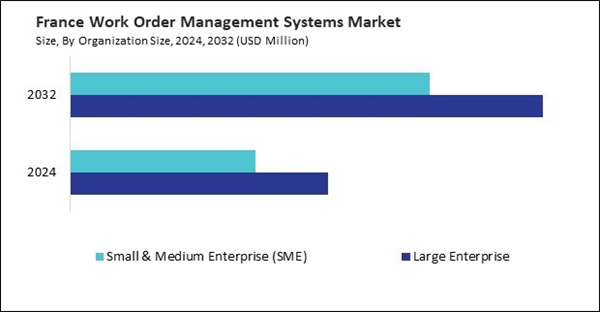The Europe Work Order Management Systems Market is expected to witness market growth of 7.6% CAGR during the forecast period (2025-2032).
The Germany market dominated the Europe Work Order Management Systems Market by country in 2024, and is expected to continue to be a dominant market till 2032; thereby, achieving a market value of $72.6 million by 2032. The UK market is exhibiting a CAGR of 6.6% during 2025-2032. Additionally, the France market is expected to experience a CAGR of 8.4% during 2025-2032.
Work order management systems find applications across a diverse range of industries, each leveraging the technology to address specific operational needs. In the manufacturing sector, these systems are used to manage production line maintenance, equipment repairs, and quality control processes. By automating work order creation and tracking, manufacturers can minimize equipment downtime, ensure timely maintenance, and maintain consistent production schedules.
In the energy and utilities sector, WOMS are employed to oversee maintenance of critical infrastructure, such as power grids, water treatment facilities, and renewable energy installations. These systems enable utilities to schedule preventive maintenance, monitor asset performance, and respond swiftly to service disruptions. The healthcare and life sciences industry utilizes WOMS to manage facility maintenance, medical equipment servicing, and compliance with stringent regulatory standards, ensuring uninterrupted operations in hospitals and laboratories.
This market in Europe is experiencing significant growth, driven by increasing digital transformation initiatives across various industries such as manufacturing, utilities, transportation, and facility management. European organizations are increasingly recognizing the importance of efficient work order management to enhance operational productivity, reduce downtime, and improve resource allocation. The growing adoption of Internet of Things (IoT) devices and automation technologies is fueling the demand for advanced work order management solutions that offer real-time tracking, predictive maintenance, and seamless integration with enterprise resource planning (ERP) systems. Emerging trends in the European WOMS market include the integration of artificial intelligence (AI) and machine learning (ML) to optimize scheduling, prioritize critical tasks, and predict potential equipment failures. Thus, Europe’s Work Order Management Systems market continues to advance with strong emphasis on sustainability, regulatory compliance, and Industry 4.0 integration.
The Germany market dominated the Europe Work Order Management Systems Market by country in 2024, and is expected to continue to be a dominant market till 2032; thereby, achieving a market value of $72.6 million by 2032. The UK market is exhibiting a CAGR of 6.6% during 2025-2032. Additionally, the France market is expected to experience a CAGR of 8.4% during 2025-2032.
Work order management systems find applications across a diverse range of industries, each leveraging the technology to address specific operational needs. In the manufacturing sector, these systems are used to manage production line maintenance, equipment repairs, and quality control processes. By automating work order creation and tracking, manufacturers can minimize equipment downtime, ensure timely maintenance, and maintain consistent production schedules.
In the energy and utilities sector, WOMS are employed to oversee maintenance of critical infrastructure, such as power grids, water treatment facilities, and renewable energy installations. These systems enable utilities to schedule preventive maintenance, monitor asset performance, and respond swiftly to service disruptions. The healthcare and life sciences industry utilizes WOMS to manage facility maintenance, medical equipment servicing, and compliance with stringent regulatory standards, ensuring uninterrupted operations in hospitals and laboratories.
This market in Europe is experiencing significant growth, driven by increasing digital transformation initiatives across various industries such as manufacturing, utilities, transportation, and facility management. European organizations are increasingly recognizing the importance of efficient work order management to enhance operational productivity, reduce downtime, and improve resource allocation. The growing adoption of Internet of Things (IoT) devices and automation technologies is fueling the demand for advanced work order management solutions that offer real-time tracking, predictive maintenance, and seamless integration with enterprise resource planning (ERP) systems. Emerging trends in the European WOMS market include the integration of artificial intelligence (AI) and machine learning (ML) to optimize scheduling, prioritize critical tasks, and predict potential equipment failures. Thus, Europe’s Work Order Management Systems market continues to advance with strong emphasis on sustainability, regulatory compliance, and Industry 4.0 integration.
List of Key Companies Profiled
- Salesforce, Inc.
- IBM Corporation
- Microsoft Corporation
- Oracle Corporation
- SAP SE
- Infor, Inc. (Koch Industries)
- ServiceNow, Inc.
- UpKeep Technologies, Inc.
- Lula Smarter Property Maintenance, Inc.
- PTC, Inc.
Market Report Segmentation
By Organization Size
- Large Enterprise
- Small & Medium Enterprise (SME)
By Component
- Solution
- Services
By Deployment Mode
- Cloud
- On-premises
By End Use
- Manufacturing
- Transportation & Logistics
- Energy & Utilities
- Construction & Real Estate
- Consumer Goods & Retail
- Telecom and IT
- Healthcare & Life Sciences
- BFSI
- Other End Use
By Country
- Germany
- UK
- France
- Russia
- Spain
- Italy
- Rest of Europe
Table of Contents
Chapter 1. Market Scope & Methodology
Chapter 2. Market at a Glance
Chapter 3. Market Overview
Chapter 4. Competition Analysis - Global
Chapter 5. Value Chain Analysis of Work Order Management Systems Market
Chapter 6. Key Customer Criteria of Work Order Management Systems Market
Chapter 7. Europe Work Order Management Systems Market by Organization Size
Chapter 8. Europe Work Order Management Systems Market by Component
Chapter 9. Europe Work Order Management Systems Market by Deployment Mode
Chapter 10. Europe Work Order Management Systems Market by End Use
Chapter 11. Europe Work Order Management Systems Market by Country
Chapter 12. Company Profiles
Companies Mentioned
- Salesforce, Inc.
- IBM Corporation
- Microsoft Corporation
- Oracle Corporation
- SAP SE
- Infor, Inc. (Koch Industries)
- ServiceNow, Inc.
- UpKeep Technologies, Inc.
- Lula Smarter Property Maintenance, Inc.
- PTC, Inc.









